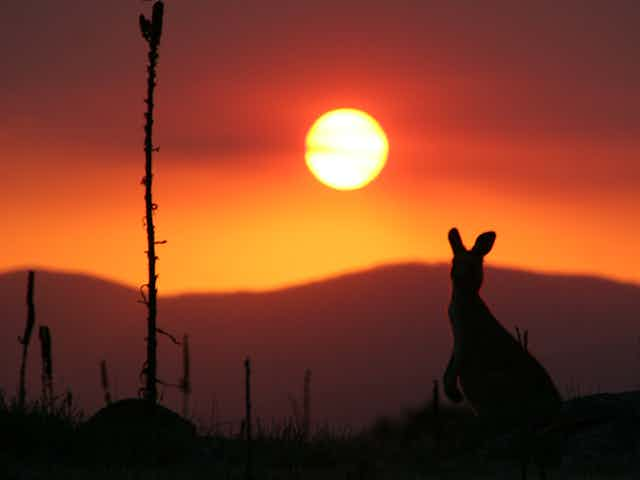It’s the time of the equinox or more specifically the spring equinox for us in the southern hemisphere.
The equinox is a midpoint. It’s around now that day and night become equal in length (but more about that later).
It’s also around the equinox that the sun does what we think it always does - it rises due east and sets due west.
And at the equinox the sun’s path sits mid-way between the extremes of summer and winter, as marked by the solstices.

A moment in time
But the equinox itself is a specific moment in time, which this year occurs at 12:29pm, Tuesday 23 (AEST). To understand what this means, we must take a different view of the Earth and the sun, one where the Earth holds centre stage.
Imagine for a moment that the Earth is at the centre of a sphere of stars, known as the celestial sphere.
Of course, this isn’t physically correct but it’s a useful device. For example, it’s the basis of the equatorial coordinate system that maps the stars onto a fixed celestial grid in the same way that we use longitude and latitude to map the Earth.

On the celestial sphere, the north celestial pole is directly above the Earth’s north pole and the south celestial pole is directly below the Earth’s south pole.
The celestial equator is the projection of the Earth’s equator out onto the celestial sphere. It splits the celestial sphere into a northern half and southern half.
In this reference frame where the Earth is fixed, the sun appears to orbit the Earth. It follows a path known as the ecliptic, which tracks the sun’s motion against the background stars.
Importantly, the ecliptic is tilted relative to the celestial equator. This is because the Earth spins on an axis that is titled by 23.5° relative to its orbital plane.
Having set this all up, it’s now possible to see the exact time of the equinox. It is the moment when the sun crosses the celestial equator.
At the spring equinox the sun is heading south of the celestial equator. While at the autumnal equinox the sun is heading north.

It’s all due to the tilt
We have such wonderful changing seasons on Earth because the Earth spins on a tilted axis.
When the south pole is tilted towards the sun, the sun’s path is high in the sky and it is summer. Six months later, when the south pole is tilted away from the sun, the sun’s path is low and it is winter.

At the equinox neither the north pole or the south pole is tilted towards the sun – remember it’s the mid-point.
This means that the Earth’s terminator or the line that separates day from night, runs from the north pole to the south pole. It’s the only time when the terminator aligns with the rotational axis of the Earth.
This is captured brilliantly in the time-lapse video below which shows a whole year in just 12 seconds. The footage is from a geostationary satellite operated by the European Organisation for the Exploitation of Meteorological Satellites (EUMETSAT).
The satellite has a constant view of Africa and it’s amazing to watch the terminator shift position as the Earth travels along its orbit around the sun.
What makes an ‘equal night’?
The term equinox is derived from Latin and means “equal night”. But surprisingly, the day of the equinox is not actually the day when daylight hours match those of night.
Instead, on the day of the equinox, it is the centre of the sun which is above the horizon for 12 hours.
Across Australia, we have about 12 hours and 8 minutes of daylight on the equinox. Some of this extra time is due to our day beginning at sunrise, when the sun first crosses the horizon, and ending at sunset, when all of the sun has disappeared below the horizon.
What’s surprising, is that this only extends our day by a couple of minutes. Most of the extra daylight is due to a strange effect known as atmospheric refraction.
The Earth’s atmosphere bends light from the sun so that at sunrise we are able to see the sun before it physically crosses the horizon. The reverse occurs at sunset. We continue to see the edge of the sun for several minutes even though it has already sunk below the western horizon.
The degree of atmospheric refraction varies with temperature and atmospheric pressure. Calculations of daily sunrise and sunset times take atmospheric refraction into account by assuming standard conditions.
So if not at the equinox, when are day and night equal in length? It depends on the latitude of your location. Up in the northern parts of Australia, it occurred almost a week ago. Down south in Hobart, it occurred just a few days ago, on September 20.
At the equator, it doesn’t happen at all. There, the length of a day doesn’t vary much across the year. But due to the way we experience sunrise and sunset, a day at the equator is always around 14 minutes longer than the night.

